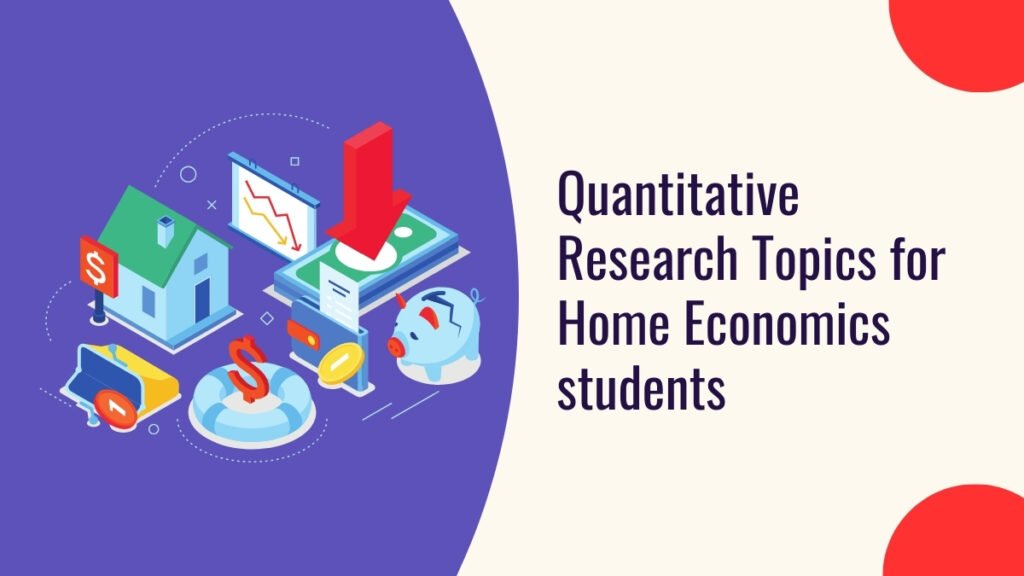Discover the power of numbers in quantitative research topics for home economics students. Explore how measurable data unveils insights into nutrition, interior design, and more.
Home economics covers fascinating topics—from nutrition science to interior design. But ever thought about using numbers to understand these everyday aspects? That’s where quantitative research comes in!
Quantitative research uses measurable data to find patterns and connections. In home economics, this means exploring how social media affects diets, testing different cleaning methods, or seeing how room colors affect sleep.
Excited to discover more through numbers in home economics? This guide will show you how. We’ll talk about why quantitative research is useful, how to collect data practically, and give you ideas for interesting research topics. Get ready to uncover new insights in the world of home economics with quantitative research!
Quantitative Research Topics for Home Economics Students PDF
Benefits of Engaging in Quantitative Research for Home Economics Students
Here’s why diving into quantitative research can transform the experience for home economics students:
Sharpen Analytical Skills
Quantitative research hones critical thinking and problem-solving abilities. From designing surveys to analyzing data, you’ll draw insightful conclusions crucial for careers in food science, marketing, and resource management.
Become a Data Detective
Home economics goes beyond recipes. Quantitative research teaches you to collect and interpret data, uncovering why consumers choose certain products, how resources are allocated, and even preferences in design.
Contribute Meaningful Insights
Your research isn’t confined to textbooks. Studies on food labeling or shopping habits can influence policymaking, providing valuable insights into consumer needs and shaping future regulations.
Inform Decision-Making
Whether managing a household or working in related fields, data analysis empowers informed decisions. Evaluate budgeting strategies, cleaning methods, or design choices with confidence based on quantitative findings.
Stand Out Professionally
In a competitive job market, quantitative skills are highly valued. Highlighting your research and data analysis expertise showcases your analytical prowess and ability to make substantial contributions in any field.
Embrace quantitative research to elevate your understanding, analytical thinking, and problem-solving skills—essential assets for success in home economics and beyond.
Understanding Quantitative Research in Home Economics
Ever wondered how numbers reveal insights in home economics? Quantitative research does just that, using data to uncover patterns and answer questions.
In simple terms, it collects and analyzes data points, like measuring ingredients for a recipe. Instead of flour and sugar, gather survey responses, time measurements, or observations.
Key features
- Hypothesis Testing: Start with a prediction (hypothesis), like “Does using a meal planning app lead to healthier food choices?” Test to prove or disprove.
- Statistical Analysis: Use tools to interpret data, identify trends, and measure relationships between variables.
Common methods
- Surveys: Questionnaires gather insights on attitudes, behaviors, or experiences.
- Experiments: Test variables like cleaning methods to observe their impact, e.g., finding the best laundry detergent.
Quantitative research in home economics turns observations into measurable insights, offering a deeper understanding of factors at home.
Quantitative Research Topics for Home Economics Students
Check out quantitative research topics for home economics students:-
Nutrition and Health
- Nutrient Analysis of School Lunch Menus
- Explore the nutritional content of school lunches over time.
- Compare with dietary guidelines for optimal health.
- Impact of Breakfast Skipping on Academic Performance
- Longitudinal study examining breakfast habits and grades.
- Correlate academic achievements with morning nutrition.
- Evaluation of Nutrition Label Accuracy
- Analyze discrepancies between food labels and lab results.
- Consumer implications for informed food choices.
- Effect of Cooking Methods on Nutrient Retention
- Experiment with cooking techniques and nutrient levels.
- Optimize meal preparation for maximum health benefits.
- Nutritional Assessment of Elderly Population
- Survey elderly care facilities for dietary patterns.
- Address nutritional gaps for improved elder health.
- Food Allergies and Dietary Management
- Survey households on allergy management strategies.
- Enhance dietary inclusivity and health outcomes.
- Impact of Nutrition Education on School Children
- Assess program effectiveness on dietary knowledge.
- Measure behavior changes for long-term health.
- Analysis of Sugar Consumption Patterns
- Survey adolescent sugar intake and health impacts.
- Promote healthier dietary choices in youth.
- Nutritional Needs of Athletes
- Customize meal plans for sports-specific nutrition.
- Optimize performance through dietary balance.
- Correlation Between Diet and Mental Health
- Study diet’s influence on mental well-being.
- Develop dietary guidelines for mental health support.
Consumer Behavior and Economics
- Consumer Preferences for Local vs. Imported Foods
- Explore factors influencing local food choices.
- Promote sustainable and community-oriented purchasing.
- Cost-Effectiveness of Meal Planning Apps
- Compare financial benefits of meal planning technology.
- Educate on budget-conscious nutrition solutions.
- Impact of Food Advertising on Purchasing Decisions
- Analyze psychological effects of food marketing.
- Foster informed consumer choices through media literacy.
- Economic Analysis of Home Gardening
- Calculate savings from home-grown produce.
- Encourage sustainable food production at home.
- Trends in Organic Food Consumption
- Track market shifts towards organic food products.
- Investigate environmental and health motivations.
- Economic Benefits of Home Cooking vs. Dining Out
- Assess financial implications of meal preparation.
- Empower families with cost-effective cooking skills.
- Consumer Perception of Food Packaging
- Survey packaging preferences and environmental impact.
- Innovate eco-friendly packaging solutions.
- Impact of Food Labeling Regulations on Consumer Choices
- Evaluate consumer response to nutritional labeling.
- Advocate for transparent food information standards.
- Analysis of Food Waste in Retail Sector
- Quantify economic and environmental costs of waste.
- Propose retail strategies for food waste reduction.
- Effectiveness of Food Assistance Programs
- Measure program impact on food security.
- Enhance accessibility and nutritional support.
Family and Resource Management
- Time Management Strategies for Working Parents
- Survey effective time allocation methods.
- Support work-life balance through household management.
- Financial Literacy Education Impact on Household Budgeting
- Evaluate education’s influence on financial stability.
- Empower families with budget management skills.
- Analysis of Energy Consumption Patterns in Homes
- Monitor and reduce household energy footprints.
- Implement sustainable energy management practices.
- Effect of Household Chores on Family Dynamics
- Study chore distribution and family relationships.
- Foster teamwork and mutual support within households.
- Evaluation of Home Organization Systems
- Test efficiency of organizational tools and systems.
- Optimize space management for household productivity.
- Impact of Home Economics Education on Teenagers’ Independence
- Measure skills development in domestic tasks.
- Prepare youth for autonomous living and responsibility.
- Comparison of Housing Options for Aging Population
- Analyze costs and benefits of elder care solutions.
- Ensure comfortable and sustainable living choices.
- Economic Analysis of Meal Preparation Services
- Assess value and convenience of meal delivery options.
- Support informed choices in meal planning solutions.
- Gender Roles in Financial Decision-Making
- Investigate financial roles within household dynamics.
- Promote equitable financial decision-making strategies.
- Environmental Impact of Household Cleaning Products
- Quantify eco-impact of cleaning choices.
- Encourage eco-friendly cleaning habits and products.
Textile and Apparel Studies
- Sustainability Practices in Fashion Design
- Assess ecological footprint of fashion production.
- Promote sustainable fashion choices and practices.
- Consumer Perception of Sustainable Fashion Brands
- Explore attitudes towards eco-friendly fashion labels.
- Educate consumers on ethical fashion consumption.
- Impact of Fast Fashion on Local Economies
- Evaluate economic repercussions of fast fashion.
- Support local industry and fair trade initiatives.
- Analysis of Textile Recycling Technologies
- Innovate textile waste management solutions.
- Develop sustainable fashion recycling programs.
- Fashion Trends and Cultural Identity
- Celebrate diversity through fashion exploration.
- Explore cultural influences on modern fashion trends.
- Evaluation of Textile Quality Standards
- Set benchmarks for textile durability and quality.
- Empower consumers with informed purchasing choices.
- Effect of Clothing Choices on Body Image
- Study psychological effects of clothing on self-perception.
- Promote positive body image through fashion empowerment.
- Historical Evolution of Fashion Trends
- Trace cultural and social shifts through fashion history.
- Preserve and interpret fashion as a cultural artifact.
- Consumer Behavior in Online vs. Offline Clothing Shopping
- Analyze digital impact on fashion consumerism.
- Enhance retail strategies for modern fashion markets.
- Impact of Textile Waste on Environmental Sustainability
- Quantify environmental consequences of textile disposal.
- Advocate for sustainable textile waste management practices.
Tips for Choosing and Conducting Your Research
Check out the tips for choosing and conducting your research:-
Choosing Your Research Topic
- Follow Your Passion: Choose a topic that genuinely interests you and can be measured with data, like how social media influences clothing choices.
- Refine Your Question: Example: “Does Instagram influencer marketing impact clothing brand preferences in teenagers?”
- Build on Existing Knowledge: Explore journals for unanswered questions or gaps.
- Consider Feasibility: Start with a manageable topic that fits your resources and time.
Conducting Your Research
- Define Your Question Clearly: Example: “Does listening to music improve college students’ grades?”
- Plan Your Methods: Decide on surveys, experiments, or other suitable methods.
- Collect Data Carefully: Pilot test surveys and ensure reliability.
- Use Statistical Tools: Analyze data with tools like SPSS for trends and relationships.
- Ethical Conduct: Obtain consent, ensure anonymity, and follow ethical guidelines.
- Report Clearly: Present findings in a structured report with methodology, analysis, and citations.
By following these straightforward steps, you can effectively conduct quantitative research in home economics, contributing valuable insights to the field.
Tips for Successful Implemetation of Quantitative Research for Home Economics Students
Check out the tips of successful Implementation of quantitative research for home economics students:-
Refine Your Topic
- Choose Wisely: Pick a topic that interests you and matches your skills.
- Data Planning: Ensure data availability and feasibility for your research question.
Build a Strong Research Design
- Clear Question: Formulate a precise research question.
- Method Selection: Use surveys, experiments, or data analysis methods that fit your question.
- Sampling Strategy: Define how to select a representative sample.
Data Collection and Analysis
- Tools: Develop clear surveys or experimental designs.
- Stats Know-How: Understand and use appropriate statistical tests.
- Data Management: Organize and clean your data effectively.
Presenting Your Findings
- Clear Communication: Write simply and explain your methods clearly.
- Visual Aids: Use tables, charts, and graphs to present data.
- Discuss Implications: Mention study limitations and suggest future research.
Additional Tips
- Review Literature: Look at existing research to guide your study.
- Ethical Considerations: Ensure ethical practices in data collection.
- Practice: Start with smaller projects to gain confidence.
By following these simple guidelines, you can conduct effective quantitative research in Home Economics and contribute meaningfully to the field.
Ethical Considerations for Quantitative Research for Home Economics Students
Ethical Guidelines for Quantitative Research in Home Economics
Informed Consent
- Explain research purpose, procedures, risks, and benefits clearly.
- Use plain language in consent forms.
- Secure written consent, especially for sensitive topics.
Confidentiality
- Protect participant anonymity.
- Use secure data storage and explain data use.
Vulnerable Populations
- Obtain parental consent for minors.
- Adapt research for vulnerable groups.
Minimize Risks
- Reduce physical and psychological risks.
- Be transparent about research goals.
Data Handling
- Clarify data ownership and sharing.
- Anonymize data before sharing.
Reporting
- Report findings accurately and transparently.
- Acknowledge study limitations.
Additional Tips
- Obtain IRB approval if needed.
- Respect participants’ time and feedback.
Following these guidelines ensures ethical conduct in Home Economics research, prioritizing participant safety and contributing responsibly to knowledge.
Conclusion
The field of home economics goes beyond traditional boundaries, offering dynamic insights into our daily lives through quantitative research. Whether you’re intrigued by understanding consumer behavior in clothing choices, evaluating the effectiveness of cleaning methods, or measuring the impact of design on productivity, there’s ample opportunity for exploration.
This guide equips you with the tools to embark on your quantitative research journey—from selecting an engaging topic to carefully collecting and analyzing data. Remember, the most compelling research often stems from your genuine curiosity. Embrace your interests, dive into measurable data, and embark on a research adventure that expands knowledge within the captivating realm of home economics!
And remember, your research journey doesn’t have to stop here. Share your discoveries with peers, present at conferences, or consider publishing in relevant journals. Quantitative research empowers you to actively contribute to the evolving field of home economics, influencing how we manage our households and navigate the world around us.



